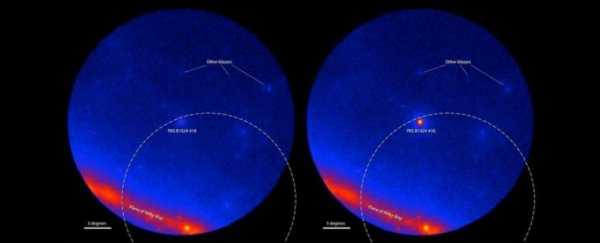Just over three years ago, physicists working in Antarctica announced they'd detected the first evidence of mysterious subatomic particles, known as neutrinos, coming from outside our galaxy. It was a huge moment for astrophysics, but since then, no one's quite been able to figure out where those particles are coming from, and what's sending them hurtling our way.
Until now, that is - a team of astronomers has just identified the possible source of one these extragalactic visitors, and it appears that it started its journey to us nearly 10 billion years ago, when a massive explosion erupted in a galaxy far, far away (seriously, George Lucas couldn't make this stuff up).
Let's step back for a second here though and explain why this is a big deal. Neutrinos are arguably the weirdest of the fundamental subatomic particles. They don't have any mass, they're incredibly fast, and they're pretty much invisible, because they hardly ever interact with matter. Like tiny ghosts, billions of neutrinos per second are constantly flowing through us, and we never even know about it.
In order to detect them, researchers have step up extravagant labs, like the IceCube Neutrino Observatory at the South Pole, where they wait patiently to capture glimpses of neutrinos streaking through the planet, and measure how energetic they are, to try to work out where they came from.
Usually that source is radioactive decay here on Earth or inside the Sun, or maybe from the black hole at the centre of our galaxy. But in 2013, the IceCube researchers announced they'd detected a couple of neutrinos so unimaginably energetic, they knew they must have come from outside our galaxy.
These neutrinos were named 'Bert' and 'Ernie' (seriously) and they were the first evidence of extragalactic neutrinos. Their discovery was followed by the detection of a couple of dozen more, slightly less energetic, extragalactic neutrinos over the coming months.
Then at the end of 2012, they spotted 'Big Bird'. At the time it was the most energetic neutrino ever detected, with energy exceeding 2 quadrillion electron volts - that's more than a million million times greater than the energy of a dental X-ray. Not bad for a massless ghost particle.
Since then, teams across the world have been working to figure out where the hell this anomaly had come from. And now we might finally have a suspect.
"It's like a crime scene investigation," said lead researcher Matthias Kadler from the University of Würzburg in Germany, "The case involves an explosion, a suspect, and various pieces of circumstantial evidence."
Using that circumstantial evidence, the best astronomers could do at the time was narrow the source down to a patch of the southern sky about 32 degrees across - roughly the size of 64 full moons.
That sounds pretty specific, but an area that size in the night sky covers a whole lot of galaxies, and researchers had the tough job of sifting through all that data to figure out what happened in one of those galaxies to send Big Bird to us.
They now think they have their answer - a huge explosion known as a blazar, which occurred in a galaxy called PKS B1424-418 around 10 billion years ago, but was only detected by our telescopes between 2011 and 2013 because of how far away it is.
A blazar is one of the most energetic events in the known Universe, and it occurs when a galaxy's material falls towards the supermassive black hole at its centre, and some of that material ends up being blasted in huge jets directly towards Earth.
Publishing in Nature Physics, the team has now calculated that there's only a 5 percent chance that Big Bird and the blazar at PKS B1424-418 coincidentally hit Earth at the same time, but weren't linked.
"Taking into account all of the observations, the blazar seems to have had means, motive and opportunity to fire off the Big Bird neutrino, which makes it our prime suspect," said Kadler.
The fact that these two individually fascinating events are associated is pretty exciting in itself.
"There was a moment of wonder and awe when we realised that the most dramatic outburst we had ever seen in a blazar happened in just the right place at just the right time," said co-author Felicia Krauß, from the University of Erlangen-Nürnberg.
This hypothesis now needs to be independently verified before we can say for sure where Big Bird, and potentially other extragalactic neutrinos, come from. But it's pretty exciting that we might finally, finally be getting close to understanding more about these enigmatic subatomic particles.
Francis Halzen, who's the principal investigator of IceCube, and wasn't involved in this study, thinks the research heralds in an exciting new time in neutrino research.
"IceCube is about to send out real-time alerts when it records a neutrino that can be localised to an area a little more than half a degree across, or slightly larger than the apparent size of a full moon," he explains. "We're slowly opening a neutrino window onto the cosmos." Bring it on.
